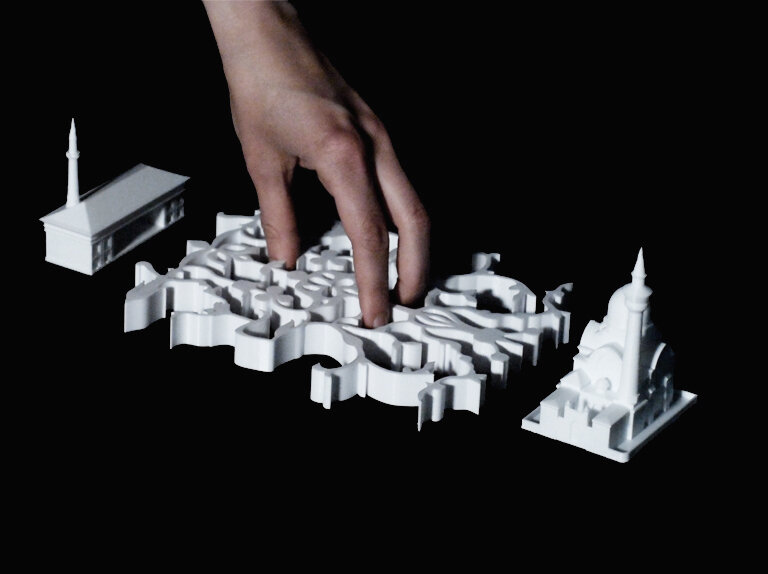
The Enchanted Gardens of Ada Kaleh
Authors’ Comment
How could narratives and artistic curation contribute to conveying the essence of cultures in peril?
Ada-Kaleh was an ancient island on the Danube, between Serbia and Romania, inhabited by a Turkish community descending from the old defenders of the Ottoman Empire. This landscape, described as a utopia with the qualities of an immense lush garden where people used to live in harmony, was destroyed and flooded by the Romanian communist government in 1970, leaving behind pieces of collective memory. The island-inspired stories, myths, and exaggerations. The only trace left of this entire cultural landscape is an impressive archive of documents, photographs, paintings, surveys, and writings.
Its destruction happened in a moment in history when technological development was more important than culture, so Ada Kaleh never had the chance to be evaluated and acknowledged as a cultural landscape.
The project advocates for its recognition as a cultural landscape, through a collection of representations, emerged from archival research, and a series of interventions strategically placed along the Danube, from Ada Kaleh to Constanta (600 km).
Since the destruction, the community has been displaced and its artifacts have been hosted in new locations. The project proposed punctual interventions, using transplant and interpretation as design methods. Knowledge gained from understanding the island is applied in these sites. They become test grounds for re-learning sustainable landscape principles of water management and efficient land exploitation that were extensively used by the community.
In Constanta, The Embroidered Garden of Delights is an enclosure protecting the carpet, that recreates the collective memory and atmosphere of the island through vegetation and offers the host city a new public garden.
On Simian Island, The Garden of Deceit is a light and scenographic landscape intervention on the fragment of the old fortress transplanted on Simian Island in 1968, made to frame the ruin as a transplanted ground, to establish a space for experimental agricultural techniques learned from the island, and to test the resilience of new plant species (referenced in myths and stories about Ada Kaleh) in the changing climate.
On the Romanian side of the Danube, where Ada Kaleh used to be, the Water Garden is a device for isolating the area of the river where the old wharf used to be. It exposes the water level variations and orients the viewer towards the emptiness that replaced the island.
On the Serbian shore, the Garden of the Giants is sited across from the Water Garden and consists of a large brutal hemisphere that isolates an iconic fragment of the island defined in the memories of the locals by three cypress trees.
The name of the project references Ferdinand Bac’s “Jardins Enchantés” - a book about an imaginary journey through 36 gardens from his own designs. This was the departure point of the project, as it illustrates a highly unexplored connection between physical and imaginary space, that have the potential to enhance and expand each other.
The work, as a whole, is a celebration and a multilayered unfolding of the archive, aiming to augment the spatial imaginary of Ada Kaleh. It proposes an experimental recovery of the flooded island using investigation, curatorial work, graphic reconstruction, and fragmentary architectural interventions. These methodologies respond to the identity of the site and its remembrance, creating an alter-ego of Ada Kaleh.
- Beyond the ruin. The conversion of the former tobacco warehouse of Isaccea
- Balneo-physio-therapeutic recovery center. Extension of Sylva Villa, Băile Govora
- Shelter with dignity
- The Bucharest City Loop
- Fort 13 Jilava. Political repression museum and research center
- Activating industrial premises – Student Center
- Hotel at Capidava
- Palaeontology research and visitor center – Hațeg District
- Memorial for the jews of Bukovina
- Agri-Park on the Nikolics domain
- Johann Michael Haydn Music Institute
- Creative Industries Factory in London
- Urban Cistern, Amman
- Refunctionalization and extension of the former sanatorium for border guards, Herculane Baths. Centre for body-mind treatment and accomodation
- “Țara Hațegului” International UNESCO Geopark. Fragments. Territorial diversity path
- The Roundhouse: built heritage academy
- Equestrian center of recovery and leisure on the former racecourse of “Nicolae Romanescu” park
- House of Movement. Ballet school and performing arts center in Bucharest
- Lacustrine Resort. The Danube River at Corabia
- Ludoteca
- Extension of the Baths ensamble, Băile Govora
- Drama Memorial
- New Public Architecture as Infill in Historical Context, Bucharest
- ECORIUM Local ecosystem research center
- Artist in Residence – Nae Petrescu Houses – Plantelor Street No. 56-58
- Extention of Public School of Arts and Crafts
- The Castle with Unicorns. Reactivation through school, arts and crafts of the Kornis Castle Ensemble in Mănăstirea Village
- House of games
- A New City Center – Conversion of the Pozzi Ceramic Factory, Laveno, Italy
- Urban Revitalization – Calea Moșilor
- Archaeological cultural center in the Constanta Peninsula
- Lapidarium. Extension of “Vasile Pârvan” Institute of Archaeology, Bucharest
- Pavilion complex within the “Măgura” sculpture camp, Buzău
- Recovery, revitalisation and insertion. Creative hub
- Integration through co-presence – Câmpulung Cultural Center
- C.U.B. Urban revitalization through social inclusion and cultural diversity
- Spatial Connections and Functional Conversion of Customs Warehouse, Bucharest
- ARTnEST – Performing Arts Center on Calea Victoriei
- Trauma and continuity – National Jewish museum, Victory Square, Bucharest
- Technological transformation hub
- The Enchanted Gardens of Ada Kaleh
- The revitalization of the Filipescu Park, Cultural Park Filipescu
- Terry Winery, Dragasani
- Mixed-function tower building (offices-hotel)
- Elca Market Square, Craiova
- The regeneration of Textila Factory
- Via Golden Quadrilateral. C Area. The Flow of Memory in Buciuman Cultural Landscape


















